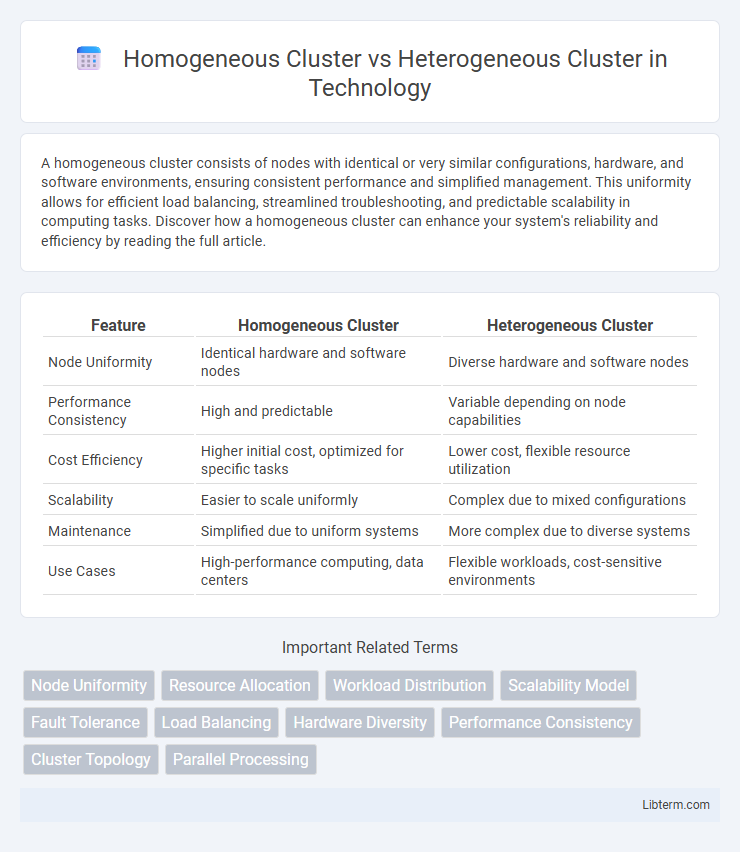A homogeneous cluster consists of nodes with identical or very similar configurations, hardware, and software environments, ensuring consistent performance and simplified management. This uniformity allows for efficient load balancing, streamlined troubleshooting, and predictable scalability in computing tasks. Discover how a homogeneous cluster can enhance your system's reliability and efficiency by reading the full article.
Table of Comparison
| Feature | Homogeneous Cluster | Heterogeneous Cluster |
|---|---|---|
| Node Uniformity | Identical hardware and software nodes | Diverse hardware and software nodes |
| Performance Consistency | High and predictable | Variable depending on node capabilities |
| Cost Efficiency | Higher initial cost, optimized for specific tasks | Lower cost, flexible resource utilization |
| Scalability | Easier to scale uniformly | Complex due to mixed configurations |
| Maintenance | Simplified due to uniform systems | More complex due to diverse systems |
| Use Cases | High-performance computing, data centers | Flexible workloads, cost-sensitive environments |
Introduction to Computing Clusters
Homogeneous clusters consist of identical or similar nodes with uniform hardware and software configurations, enabling predictable performance and simplified maintenance in computing environments. Heterogeneous clusters integrate diverse nodes with varying architectures, operating systems, or hardware capabilities, allowing flexible resource utilization and handling of complex workloads. Understanding these cluster types is crucial for optimizing computing clusters in high-performance computing, big data processing, and cloud infrastructure.
What is a Homogeneous Cluster?
A Homogeneous Cluster consists of nodes with identical hardware configurations, operating systems, and software environments, ensuring consistent performance and simplified management. This uniformity minimizes compatibility issues and enhances resource allocation efficiency in parallel computing and distributed systems. Organizations leverage homogeneous clusters for applications requiring predictable behavior and streamlined maintenance.
What is a Heterogeneous Cluster?
A heterogeneous cluster consists of nodes with varying hardware configurations, operating systems, or software environments, enabling diverse computing resources to work together. This type of cluster enhances flexibility and resource utilization by integrating different types of servers, processors, and storage devices. Heterogeneous clusters are often used to optimize performance for complex tasks and support varied workloads in distributed computing environments.
Key Differences Between Homogeneous and Heterogeneous Clusters
Homogeneous clusters consist of identical nodes with uniform hardware and software configurations, ensuring consistent performance and simplified management. Heterogeneous clusters combine different hardware or operating systems, offering flexibility to integrate diverse resources but requiring complex coordination and load balancing. Key differences include hardware uniformity in homogeneous clusters versus varied components in heterogeneous ones, impacting scalability, fault tolerance, and maintenance strategies.
Performance Comparison: Homogeneous vs Heterogeneous
Homogeneous clusters, composed of identical hardware and software configurations, typically deliver consistent and predictable performance due to uniform resource allocation and simplified load balancing. Heterogeneous clusters integrate diverse hardware and software components, which can enhance overall computational power and flexibility but may introduce performance variability and greater complexity in resource management. Performance comparison reveals that homogeneous clusters excel in stability and ease of maintenance, while heterogeneous clusters offer potential for optimized workload distribution tailored to specific tasks, albeit with increased overhead.
Scalability in Homogeneous and Heterogeneous Clusters
Scalability in homogeneous clusters benefits from uniform hardware and software configurations, enabling easy replication and predictable performance as nodes are added. Heterogeneous clusters offer flexibility by integrating diverse systems with varying capabilities, but scalability may be limited by compatibility challenges and uneven workload distribution. Efficient scaling in heterogeneous environments requires sophisticated resource management to balance performance disparities across different node types.
Cost Considerations for Cluster Deployment
Homogeneous clusters, consisting of identical hardware and software configurations, typically offer lower maintenance and management costs due to simplified compatibility and streamlined support processes. Heterogeneous clusters, involving diverse hardware or operating systems, may increase deployment expenses through the need for specialized integration, varied licensing fees, and complex troubleshooting. Evaluating total cost of ownership (TCO) requires assessing hardware uniformity, software compatibility, and scalability demands to optimize budget allocation for cluster deployment.
Use Cases of Homogeneous Clusters
Homogeneous clusters consist of identical or similar hardware and software configurations, making them ideal for high-performance computing tasks such as scientific simulations, big data analytics, and large-scale web hosting where predictable performance and simplified management are crucial. They enhance resource utilization efficiency by providing consistent processing power, memory, and storage capabilities across all nodes. Use cases often include data centers running parallel processing applications, cloud service providers delivering uniform virtual machine instances, and enterprises requiring stable environments for transaction processing systems.
Use Cases of Heterogeneous Clusters
Heterogeneous clusters combine different types of hardware or nodes, such as CPUs, GPUs, and specialized accelerators, optimizing workloads that require varied computational resources. Common use cases include machine learning training, scientific simulations, and big data analytics, where diverse processing capabilities enhance efficiency and scalability. These clusters enable dynamic resource allocation, improving overall system performance for complex, multi-faceted applications.
Choosing the Right Cluster for Your Needs
Selecting the right cluster depends on workload requirements and resource allocation preferences. Homogeneous clusters, composed of identical nodes, offer simplified management and predictable performance, ideal for consistent, compute-intensive tasks. Heterogeneous clusters combine different node types, providing flexibility for varied workloads and cost optimization by leveraging specialized hardware for specific functions.
Homogeneous Cluster Infographic

 libterm.com
libterm.com